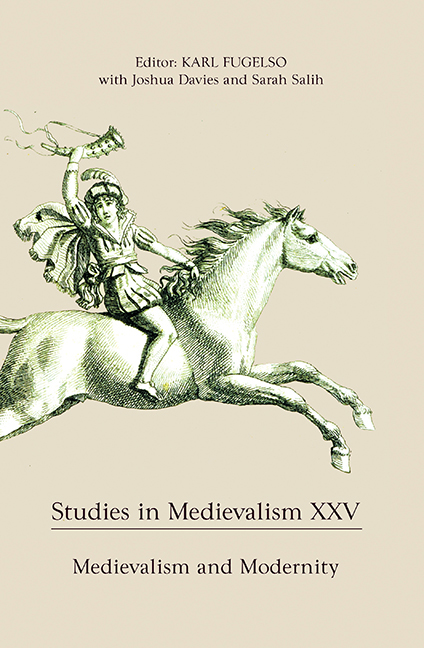Book contents
- Frontmatter
- Studies in Medievalism
- Acknowledgments
- Contents
- List of Illustrations
- Volume XXV 2016
- Editorial Note Karl Fugelso
- I Medievalism and Modernity: Some Perspective(s)
- II Medievalist Visions
- Introduction
- In/visible Medieval/isms
- Art, Heritage Industries, and the Legacy of William Morris in Michel Houellebecq's The Map and the Territory
- Travel in Space, Travel in Time: Michael Morrow's Approach to Performing Medieval Music in the 1960s
- Imagining Medieval Chester: Practice-based Medievalism, Scholarship, and Creativity
- The Anachronic Middle Ages: Public Art, Cultural Memory, and the Medievalist Imagination
- Medievalisms of Moral Panic: Borrowing the Past to Frame Fear in the Present
- Extra-Temporal Place Attachment and Adaptive Reuse: The Afterlives of Medieval English Anchorholds
- Here Be Dragons: Mapping Space and Time, Medieval and Modern
- Contributors
- Miscellaneous Endmatter
In/visible Medieval/isms
from II - Medievalist Visions
Published online by Cambridge University Press: 05 July 2016
- Frontmatter
- Studies in Medievalism
- Acknowledgments
- Contents
- List of Illustrations
- Volume XXV 2016
- Editorial Note Karl Fugelso
- I Medievalism and Modernity: Some Perspective(s)
- II Medievalist Visions
- Introduction
- In/visible Medieval/isms
- Art, Heritage Industries, and the Legacy of William Morris in Michel Houellebecq's The Map and the Territory
- Travel in Space, Travel in Time: Michael Morrow's Approach to Performing Medieval Music in the 1960s
- Imagining Medieval Chester: Practice-based Medievalism, Scholarship, and Creativity
- The Anachronic Middle Ages: Public Art, Cultural Memory, and the Medievalist Imagination
- Medievalisms of Moral Panic: Borrowing the Past to Frame Fear in the Present
- Extra-Temporal Place Attachment and Adaptive Reuse: The Afterlives of Medieval English Anchorholds
- Here Be Dragons: Mapping Space and Time, Medieval and Modern
- Contributors
- Miscellaneous Endmatter
Summary
The objects of the past stand before us, but the worlds from which they come are long gone. What should we do with these visual orphans?
Late medieval London was, like contemporary London, the greatest city of the realm, a center of power, finance, trade, and culture. It mythologized itself as Troynovant, ”.e firste citie of Brettayne,” built by Brutus. And yet the depredations of time – or, specifically, of fire, bombing, and redevelopment – ensure that medieval London is barely visible today. There are, of course, two world heritage sites, the Tower of London and Westminster Abbey, bookending the city to east and west. But most of medieval London is hidden, or glimpsed in passing, or a trace of something lost, or virtual. The City's street plan is still substantially medieval: the stone or glass palaces of the financial institutions cluster on streets named for medieval parishes and commodities. Medieval material survives underground, in crypts and cellars; lost buildings such as Baynard's Castle are commemorated with blue plaques. Or one might see, momentarily, a medieval illusion: from the corner of an eye misrecognize Renzo Piano's ultra-modern Shard (completed in 2013) as a scaled-up church spire. Seeing medieval London takes effort, imagination, luck, or knowledge. The city offers chance, routine, and quotidian encounters with the Middle Ages, of which its inhabitants and visitors might not even be conscious. Bruno Latour writes of the packaging of time into mate rial culture, “Time is always folded. […] Action has always been carried on thanks to shifting the burden of connection to longer- or shorter-lasting entities.” The past acts on the present through material things: in London, the medieval past acts upon the present even in the absence of those material things, operating through the spaces where they were. If I walk from London Bridge to the Strand, for example, I follow much the same route as I would have 600 years ago, though what I see is almost entirely different. The medieval city thus acts on me, through me, as it determines my steps, whether I remember to think so, or not.
- Type
- Chapter
- Information
- Studies in Medievalism XXVMedievalism and Modernity, pp. 53 - 70Publisher: Boydell & BrewerPrint publication year: 2016

